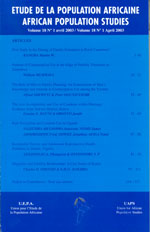
|
African Population Studies
Union for African Population Studies
ISSN: 0850-5780
Vol. 28, No. 3, 2014, pp. 1233-1247
|
 Bioline Code: ep14063
Bioline Code: ep14063
Full paper language: French
Document type: Research Article
Document available free of charge
|
|
|
African Population Studies, Vol. 28, No. 3, 2014, pp. 1233-1247
| fr |
Zieba, Félix Watang
Résumé
La dynamique urbaine récente qui touche les pays du sud s’est manifestée rapidement au Cameroun par l’émergence des villes millionaires que sont Yaoundé et Douala. Ces villes situéesdans la partie méridionale du pays ont bénéficié jusqu’au début des années 1980, de l’essentiel du flux des populations venant de toutes les autres régions du pays. La partie septentrionale, espace le plus peuplé du pays était alors considéréecomme point de depart vers les villes méridionales au détriment des villes septentrionales. Cependant à partir de la fin de la décennie 1980, on notera un développement rapide des principales villes de cette partie du territoire. Des enquêtes ont été menéesdans les trios principales villes septentrionales (Maroua, Garoua, Ngaoundéré) et dans les villes secondaires de Kousséri, Guider, Figuil auprès des communautés des immigrés et des autorités locales. Il s’est agit d’identifier les pays d’origine des immigrés et leur role dans la dynamique urbaine. Les données issues des different recensements de la population ont aussi été utilisées. Les analyses statistique, cartographique et qualitative des données démographiques issues des enquêtes de terrain et des recensements généraux de la population et de l’habitat (RGPH) de 1987 et 2005, font apparoir un développement du phenomena urbain dans cette region tant du point de vue démographiqueque spatio-économique en relation avec l’internationalisation du champ migratoire nord camerounais.
Mots Clés
dynamique; urbaine; migrations transfrontalières et internes; Nord Cameroun
|
| |
| en |
Immigration, croissance démographique et dynamique urbaine au Nord Cameroun
Zieba, Félix Watang
Abstract
The emergence of towns with millions of people like Yaounde and Douala in Cameroon is a rapid
manifestation of the recent urban dynamics taking place in the countries of the south. These towns which are
located in the southern part of the country benefitted from the influx of population from other regions of the
country up to the early 1980’s. The north of Cameroon which is the most populated part of the country was a
departure point to the towns of the south to the detriment of the towns of the north. Nevertheless there was
a rapid development of the major towns of this part of the territory from the end of the 1980 decade. Surveys
were carried out on the migrants’ communities and the local authorities in the three major towns of the north
(Maroua, Garoua, Ngaoundere) and in the secondary towns of Kousseri, Guider and Figuil to identify the
countries of origin of the migrants and their role in urban dynamics. Data from the recent population census
was also used. Statistical, cartographic and qualitative analysis of demographic data from field survey and the
national population and housing census (RGPH) of 1987 and 2005, brings out an urban development
phenomenon in this region on both a demographical and spatio economical view point in relation with the
internationalisation of north Cameroon migratory field.
Keywords
urban dynamics; transfrontier and internal migration; North Cameroon
|
| |
© Copyright 2014 - African Population Studies
Alternative site location: http://www.uaps-uepa.org
|
|
